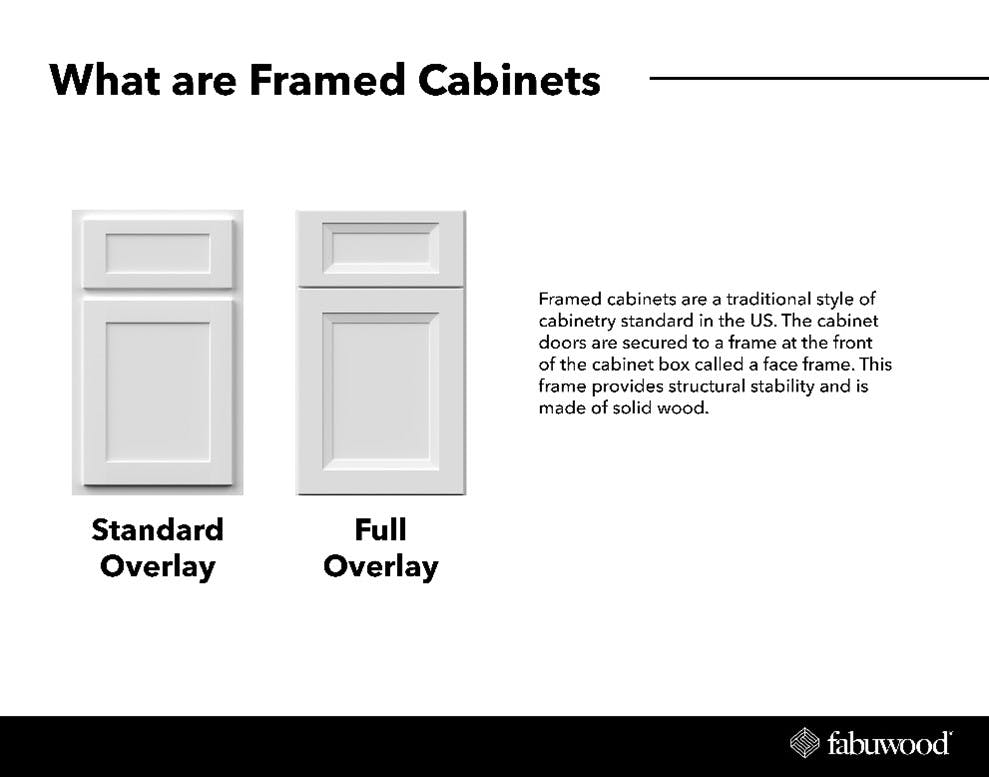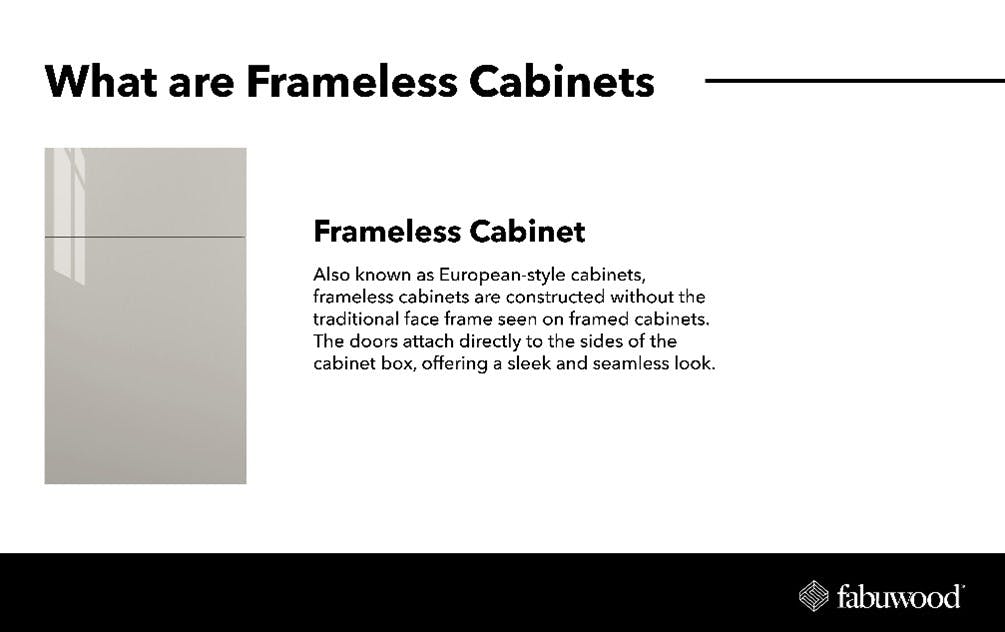Framed Vs. Frameless Kitchen Cabinets
Framed kitchen cabinets, a classic, durable choice, have long been a staple in kitchen design. However, if you're after a more contemporary look, frameless cabinets offer a sleek, modern aesthetic popular in contemporary kitchen designs.
Deciding between framed and frameless cabinets depends on design trends and personal preferences. This article compares the two, helping you determine which style best suits your kitchen.
What are Framed Cabinets?

Framed cabinets are a traditional style of cabinetry standard in the US. The cabinet doors are secured to a frame at the front of the cabinet box called a face frame. This frame provides structural stability and is made of solid wood.
The 1 ½ inch wide frame around the cabinet opening provides a base for hinges and can affect the amount of accessible space inside the cabinet. This style allows for versatile design with various door options, including inset overlay, standard overlay, and full overlay.
Standard – or traditional – overlay doors and drawer fronts show more of the face frame, like our Quest series door style. In our Allure series, full overlay doors cover the entire face frame. The inset overlay door is entirely flush with the frame. When you choose a framed cabinet, you can select any of these three overlay styles.
What are the Advantages of Framed Cabinets?
Framed cabinets have several advantages. They offer a traditional, classic aesthetic that works well with traditional homes. They have many design possibilities, including different door mount styles like full overlay, partial overlay, and inset.
Framed cabinets also offer installation flexibility. When installed, the face frame can compensate for uneven walls or floors, making the doors easier to align correctly. The hinges are also easily adjustable, allowing for easier door alignment.
For those who want to install undercabinet and inner-cabinet lighting, the face frame of framed cabinets hides the lighting easily, allowing for a seamless integration of the lighting.
Made from high quality wood, framed cabinets lend a welcoming warmth and coziness to the kitchen.
What are the Disadvantages of Framed Cabinets?
One of the common complaints with framed cabinets is the slight “lip” inside the cabinet. The lip is part of the face frame that extends into the cabinet opening. It is visible when the doors are open and acts like a border around the interior edge of the cabinet. It can reduce the accessibility to items in the cabinet since pots and pans can bump on this ledge instead of moving in and out easily.
To address this common problem, Fabuwood’s cabinets are crafted with a flush fit, so the bottom shelves of all cabinets are flush with the frame. This means easy in-and-out access without bumping into the usual ledge.
Another common disadvantage of framed cabinets is the center stile in a double-door framed cabinet. The stile divides the cabinet opening with a vertical frame piece, restricting access to larger items.
What are Frameless Cabinets?

Also known as European-style cabinets, frameless cabinets are constructed without the traditional face frame seen on framed cabinets. The doors attach directly to the sides of the cabinet box, offering a sleek and seamless look. This design provides a full-access opening, making using the entire cabinet space easier. With cabinets like those in our Illume series, the frameless cabinet offers a modern, minimalist look.
What are the Advantages of Frameless Cabinets?
Frameless cabinets, with wider drawers and openings, offer a practical solution for maximizing storage space. Frameless cabinets can significantly enhance the space's functionality, using every inch of space.
The sleek, contemporary aesthetic associated with frameless cabinets offers a clean, modern look, with doors and drawers fitting closely together.
What are the Disadvantages of Frameless Cabinets?
While they are ideal for modern aesthetics, there are significantly fewer style options for frameless cabinets. They are also limited to full overlay doors.
Installation of frameless cabinets is also more difficult for DIYers since there is no face frame to provide additional alignment, and any errors in leveling may be more noticeable. Our adjustable legs on our frameless cabinets solve this common problem, allowing for quick adjustments on unlevel flooring.
For those that love a unique custom look, frameless cabinets have few customization options due to the use of laminate material in the cabinet. While they can be customized, there isn't a variety of options available.
Another common disadvantage is that hinges are mounted directly on the cabinet sides, which could put extra stress on the cabinet, especially if it is made from MDF. However, our use of BLUM quick-release compact clip hinges allows for one-click installation and easy adjustment, contributing to the high-quality build of both our framed and frameless cabinets.
Frameless cabinets also cost a bit more than framed cabinets. The cabinet box is crafted with stronger materials to compensate for the lack of frame, making the cabinets heavier than framed. This additional construction creates a difference in cost, a significant factor to consider when deciding between framed and frameless cabinetry.
What is the Difference in Cost Between Framed and Frameless Cabinets?
Our framed Allure and frameless Illume cabinetry lines offer a range of prices. From the most cost-effective to the higher range, there is a 23% difference in cost. From the most cost-effective frameless Illume cabinetry to the higher range, there is a 17% increase.
When comparing the two most cost-effective options, framed vs. frameless, there is a 14% increase. When comparing the two higher-range options, there is an 8.5% increase. The most cost-effective frameless option is still less expensive than the costliest framed option. Our range of prices offers the most options to find your ideal cabinet style, no matter your budget.
Choosing between framed and frameless kitchen cabinets largely depends on your style preferences, functional needs, and budget. Framed cabinets offer timeless durability and various design options, making them ideal for traditional settings.
On the other hand, frameless cabinets provide a modern look and maximize storage space, perfect for contemporary kitchens. Each style has unique advantages and potential drawbacks, so consider what will best complement your home's décor. Contact your local dealer for help deciding which style fits your kitchen well.
